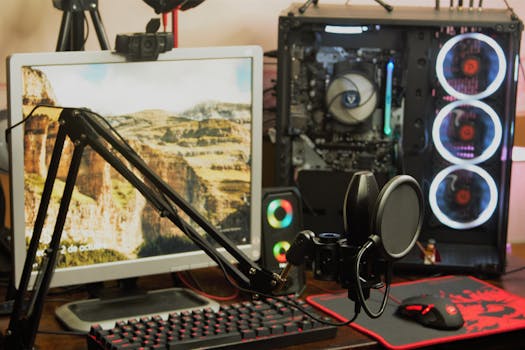Creating gaming materials may seem daunting, but it’s an enjoyable endeavor that can enhance your gaming experiences significantly. Whether you’re designing for tabletop role-playing games, board games, or even video games, the right materials can elevate gameplay.
This guide will walk you through the essential steps involved in crafting gaming materials. By the end of this article, you’ll feel empowered to bring your creations to life. With some creativity, organization, and attention to detail, your gaming materials will resonate with players and heighten the overall experience.
From concept development to final production, every phase is crucial for ensuring that players engage with your material. Let’s explore these stages in detail, offering practical tips and resources along the way.
Understanding the Basics of Gaming Materials
The first step is to understand the various types of gaming materials available. Each type serves a unique purpose, affecting how players interact with the game. Common types include character sheets, rulebooks, game boards, and dice.
Character sheets allow players to track their abilities and progress. They should be clear and easy to read, ensuring players can focus on gameplay rather than paperwork. Rulebooks are essential, providing comprehensive guidelines on game mechanics.
Game boards set the stage for encounters, while dice introduce an element of chance. Each material should complement the others, enhancing the game’s theme and mechanics. Properly designed materials can significantly improve player immersion.
Consider your audience when creating these materials. Different demographics have varying preferences, so identifying your target group will guide your design choices. Consulting with potential players can yield valuable insights during the creation process.
Once familiar with the essentials, the next step is to shift your focus to brainstorming ideas. Creativity plays a pivotal role in making your materials engaging and memorable for players.
Brainstorming Ideas for Your Game
Brainstorming is an iterative process that allows for idea generation and exploration. Gather a team or conduct a solo session to allow thoughts to flow freely without judgment. Various ideation techniques can be employed.
Mind mapping is one effective method; it visually organizes ideas, showing relationships between concepts. Alternatively, you can utilize free writing, jotting down everything that comes to mind about your game and its mechanics.
Routine brainstorming sessions help in refining ideas, finding themes, or establishing mechanics. Be open to exploring unconventional avenues; sometimes, unique ideas emerge when you least expect them. Ensure every concept aligns with the game’s vision.
Incorporating feedback from friends or fellow gamers can fine-tune your ideas. Constructive criticism can highlight strengths and weaknesses, improving the clarity and appeal of your gaming materials. People often see things differently!
Creating a diverse pool of concepts allows you to select the most engaging aspects later. Once you’ve compiled your ideas, you can categorize and refine them, leading to more developed gaming materials.
Designing the Visual Elements
Visual design is crucial in engaging players and communicating game mechanics effectively. Create aesthetically pleasing materials that invite players to interact. Start by defining the game’s theme and style.
Utilize color schemes, typography, and illustrations that support the narrative and mechanics. Ensure consistency across all materials; it adds professionalism and coherence. Tools such as Canva or Adobe Illustrator can aid in design processes.
Gamers appreciate quality artwork; consider hiring an illustrator if your budget allows it. Unique visuals can set your game apart from the competition, enhancing its marketability. Even small details can leave a significant impact.
Additionally, remember to test your designs. Usability testing with real players can uncover potential issues within your materials. This phase allows you to make adjustments that enhance player experience before finalizing your designs.
Once you’re satisfied with the visuals, prepare for the next stage: prototyping your gaming materials. This process ensures your ideas materialize in a tangible format.
Prototyping Your Gaming Materials
Prototyping is a vital step that brings your concepts to life, allowing you to see how components interact during actual gameplay. Start with paper prototypes for simplicity and affordability.
Create simple versions of your character sheets and game boards using available materials. This basic approach allows for easy adjustments based on player feedback. As a result, you save time and resources in the long run.
Once the paper prototypes effectively illustrate gameplay, consider digital options. Software like Tabletop Simulator can help simulate your game and offer a unique platform for virtual playtesting.
Gather players to test your prototypes and observe their interactions. Note areas for improvement and be open to revising components based on feedback. Iterative testing refines your design, improving overall playability.
After incorporating feedback, create another iteration of your prototypes. Continue this cycle until you feel confident in the materials. A polished final product ensures players enjoy the gaming experience to the fullest.
Playtesting and Gathering Feedback
Playtesting is essential to ensure your game materials work as intended. Organize sessions with different groups to gather expansive perspectives. Each player may approach gameplay differently, providing diverse feedback.
During playtests, observe how players interact with your materials. Are there confusion or issues that need addressing? Note the flow of gameplay and ensure that rules promote engagement rather than disrupt it.
Gather feedback systematically; use surveys or direct conversations after sessions to encourage honest input. Ensure participants feel comfortable sharing their thoughts openly. This honest dialog can lead to valuable insights.
Incorporating feedback allows you to refine your materials continually. Adaptation is key; some aspects may need significant changes while others could remain intact. Always prioritize enhancing player experience in iterations.
Ultimately, frequent playtesting and revisions will help others appreciate your hard work. It’s about ensuring your materials succeed, leading to memorable gaming sessions. With proper feedback, you can perfect your game’s design.
Finalizing and Producing Materials
After numerous revisions and testing phases, you’re ready to finalize your gaming materials. The clarity of rules and aesthetics must align with your vision, making the end product engaging and accessible.
Select appropriate printing methods and materials, considering durability and quality. Options include online printing services, local print shops, or even DIY methods. Decide based on your budget and intended use.
Utilize high-resolution images for artwork to ensure quality visual representation. Double-check proofs before printing to maintain accuracy. This detail helps avoid costly mistakes that could detract from your materials.
If you plan to distribute your game online, create digital versions of all materials. Ensure files are compatible across platforms, making it easier for players to access resources during gameplay.
Once you receive your final products, it’s time for distribution. Cultivating a community around your game can boost popularity and awareness. Use social media platforms to begin this engagement.
Marketing Your Gaming Materials
Marketing is vital for gaining visibility in the competitive gaming industry. Begin by developing a marketing strategy that highlights your unique selling points. Define your target audience clearly.
Engaging on social media allows for efficient community building. Share content with visuals and gameplay demonstrations to entice potential players. Interactive posts can generate interest and foster community support for your project.
Consider utilizing crowdfunding platforms to gauge interest and secure initial funding. Platforms like Kickstarter allow you to showcase your materials and gather immediate feedback while building a customer base.
Participate in gaming conventions or local events to showcase your game. In-person demos enable direct interaction with your target audience, creating memorable experiences and opportunities for feedback.
Lastly, continuously review your marketing efforts. Use metrics to gauge effectiveness, making adjustments as needed. Dedication to marketing will ensure your game receives the attention it deserves.
Conclusion
Creating gaming materials can be a rewarding journey filled with creativity and storytelling. By understanding the basics, brainstorming effectively, and involving playtesters, you can develop engaging experiences.
Design, prototyping, and marketing are crucial steps in turning ideas into fantastic gaming materials. Collaboration and feedback improve the final product, ensuring players enjoy rich and immersive gameplay.
Your journey in crafting these materials can unite players and generate lasting memories. So, roll up your sleeves and dive into the world of gaming material creation, transforming ideas into reality!


